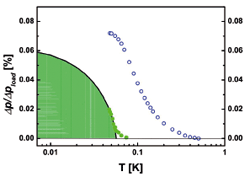Vortex Physics in hcp solid 4He and
a new development of Superfluidity Study
Kubota Group
The report of the Kubota group on the evidence for quantized vortices and the vortex fluid (VF) state[1] has been stirring the low temperature community. Additional reports on the possible transition from the VF state into a 3D supersolid(SS) state[2] are further exciting the community, although there is neither a microscopic theory nor common understanding of the description of all the experimental observations reported so far for the solid 4He.

Fig. 1. “Non Linear Rotational Susceptibility(NLRS)” of the vortex fluid state (open symbols) and the hysteretic component of NLRS, ΔNLRShys(filled symbols) which we discuss to be supersolid density ρs, as a function of T. The high temperature part of NLRS behaves as 1/T2, whereas ρs starts from Tc and increases towards T = 0K and the latter behaves as an order parameter whereas NLRS does not behave as an order parameter. The NLRS of VF is found to behave as “paramagnetic”, with Langevin function with x ∝ 1/T2. Langevin function behavior is expected for susceptibility of an ensemble of classical dipoles, but usually with x ∝ 1/T.
Proposals for the existence of supersolid state in a quantum solid, solid 4He go back to the 1960’s. The reason for expecting such a peculiar state of coexistence of order in real space, the lattice structure of the solid, combined with simultaneous order in momentum space, as required for the superfluidity is based on the fact that disorder, actually, vacancies and interstitials should exist to some extent even at absolute zero temperature in some quantum solids on account of the large zero point motions. Since the time when the “classical proposals” were made around 1970[3], there have been substantial experimental efforts exerted to discover such a state over more than 35 years, before Kim and Chan announced their first “possible non-classical rotational inertia”(NCRI) observation in solid 4He samples formed in Vycor porous glass in January 2004[4] by torsional oscillator(TO) technique. They reported also results with bulk torous samples[5] with and without a blockage to test the macroscopic feature of the observation. Confirmation of Kim and Chan’s experimental observations by other groups took quite some time and it was around the beginning of 2006, when other groups including the Kubota group started reporting similar results. This was because the features of the phenomena are quite sensitive to very small ac excitation velocities in the TO experiments. As little as 10 μm/s linear speed seemed to cause decrease of the TO signals substantially. It was, however, also becoming problematic to expect BEC of any quasi particles(vacancies or interstitials) or other excitations at 200 mK or so as reported by Kim and Chan[4, 5] considering the known densities of these excitations.
It was P. W. Anderson, who proposed the vortex fluid scenario[6] for the experimental observations reported till 2007. His point is as follows; the reported “onset temperature” of 200 mK[4] to 500 mK[1] is too high to expect BEC to occur from the knowledge of number density of vacancies or interstitials and reported logVac linear dependence[4, 5], where Vac is the linear velocity at the torsion pendulum edge. This indicates involvement of vortex lines in the observation. He also pointed out that the reported TO results would represent non-linear rotational susceptibility(NLRS) of the VF state[6].
Penzev, et al., [1] reported a clear finding of the onset temperature To at 500 mK for samples at 32 and 49 bar pressure, the highest To ever reported for solid 4He, where significant Vac dependence starts to appear. The TO response of solid 4He has a unique feature, which is opposite to the behavior of superfluid transition of all known superfluids. Namely, the TO signals become larger when the excitation is smaller over decades of amplitude change. We discuss that it is fluctuation of the thermally excited quantized vortices in the VF state[1]. The VF state has been observed and heavily discussed in various new types of superconductors starting from the Cuprate superconductors. Evidence of quantized vortices has been reported especially for Under-doped Cuprate superconductors[7]. The VF state in He is expected to become a 3D supersolid state at lower temperatures below some Tc, because of increase of low D coherence length towards lower T, which originates in lower dimensional subsystems in the system and causes a transition to a SS state with macroscopic coherence.
We have experimentally found a transition from the VF state to the SS state by observing a hysteresis in the TO response with changing excitation below a temperature, Tc [2]. Fig. 1 shows the T dependence of both NLRS of VF and the hysteretic component of NLRS, which we argue to be associated with supersolid density ρs. Both are plotted as functions of T. This observation is consistent with our preliminary results of TO measurements under DC rotation, where the evidence of vortex lines penetration occurs below the same Tc ~ 75 mK, far below To.
References
- A. Penzev, Y. Yasuta, and M. Kubota, Phys. Rev. Lett. 101, 065301 (2008).
- M. Kubota, N. Shimizu, Y. Yasuta, P. Gumann, and S. Nemirovskii, J Low Temp Phys, DOI 10.1007/s10909-009-0049-y.; N. Shimizu, Y. Yasuta, and M. Kubota, arXiv:0903.1326., submitted to Phys. Rev. Lett..
- see a review, for example, D. Galli and L. Reatto, J. Phys. Soc. Jpn. 77, 111010 (2008).
- E. Kim and M. H. W. Chan: Nature 427 225 (2004).
- E. Kim and M. H. W. Chan: Science 305 1941 (2004).
- P. W. Anderson, Nat. Phys. 3 (2007) 160; Phys. Rev. Lett. 100 215301 (2008).
- Y. Wang, L. Li, M. J. Naughton, G. D. Gu, S. Uchida, and N. P. Ong, Phys. Rev. Lett. 95, 247002 (2005).
